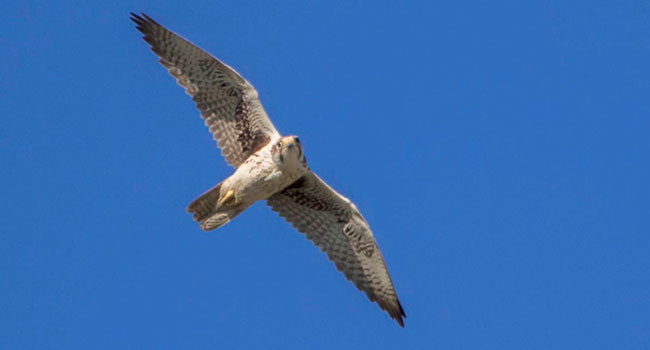A popular Edmonton, Alberta landmark for local birdwatchers is teaching some valuable lessons about falcons – some of the most difficult raptors to observe.
The Alberta Grain Terminal, a hulking brick structure in west Edmonton that’s been used to load grain rail cars for 96 years, is also a hotspot for pigeons and their predators, prairie and Arctic-breeding gyrfalcons, and University of Alberta researchers have updated what’s known about how the birds interact at the facility.
A new study, published in The Canadian Field Naturalist, puts to flight some earlier assumptions birders had made about the hunting practices of the falcons, said Marissa Lynds, who led the research as an undergraduate student for a directed studies project in the Faculty of Agricultural, Life & Environmental Sciences.
By observing the birds at the terminal through the winters of 2018-2019 with her co-author, researcher John Acorn, reviewing his years of notes and those of birdwatchers, Lynds was able to update data from a 2001 scientific paper that discussed the falcons’ hunting methods from 1998 to 2000.
“It had been nearly 20 years, so we thought an update was due,” said Lynds, who has since graduated with a degree in conservation biology.
The new findings also correct some general assumptions among the birdwatching community and in the earlier study about the attraction of pigeons to the terminal, the falcons’ hunting skills and their preferences for certain colours of pigeons.
Though spilled grain was originally thought to be the biggest reason pigeons flock to the terminal, in fact, it’s the warmth of the building, the study showed. The terminal acts as an “urban south-facing slope” that offers lots of roosting places, Lynds said. On cloudy days, the building is up to 10 degrees warmer than outside temperatures and on sunny days, up to 23 degrees warmer.
Prairie falcons – regularly spotted at the terminal along with gyrfalcons – were also thought to be twice the hunter that their tundra-dwelling cousins were, but the study showed “it really depends on the skills of individual birds,” Lynds said.
According to the 2001 study, prairie falcons were 26 per cent successful at hunting pigeons, versus the gyrfalcon at 10.6 per cent. But the new study showed the opposite, with a 21 per cent success rate for gyrfalcons and a rate of 10.6 per cent for their prairie cousins. “This makes us think that individual hunting skills could be a factor.”
Based on photographic data gathered by U of A students and study co-authors Jamie Card and Hayley Hedstrom in 2016, the new research also overturns an assumption that falcons prefer to hunt darker-coloured pigeons for their high visibility against snow or winter skies. Though the evidence didn’t support a hunting preference for black pigeons any more than other colour groups, they did show a slight preference for black and white pigeons, possibly for their resemblance to the rock ptarmigan, an Arctic grouse frequently hunted by the gyrfalcon.
Though the grain terminal is a unique situation that strongly influences the birds’ behaviour, the overall findings help build knowledge about how they behave in urban settings, said Acorn, who has spent years studying and taking video of the popular roost for birdwatchers.
“Programs in other places that hope to use trained falcons to scare pigeons away from particular areas could learn from the grain terminal, where falcons don’t seem to be much of a deterrent and hundreds of pigeons return day after day, despite continual predation by wild falcons – which are generally better hunters than trained ones.”
Their study could also set an example for how to study urban areas attractive to birds or other raptors, Lynds said. “The terminal shows how buildings can mimic a natural setting or how birds have adapted to use them in urban settings.”
The terminal also gives observers a rare glimpse into the behaviour of an animal that may live seven months of the year in wilderness far to the North. “You don’t see gyrfalcons hunting in an urban setting very often,” said Lynds.
“It’s remarkable to see the power behind a falcon and the pigeon behaviour – it’s a crazy game of chase above your head. Any birder or biologist who visits the terminal regularly and eventually sees a falcon hunt is going to instantly be hooked.”
| By Bev Betkowski for © Troy Media
The views, opinions and positions expressed by columnists and contributors are the author’s alone. They do not inherently or expressly reflect the views, opinions and/or positions of our publication.


